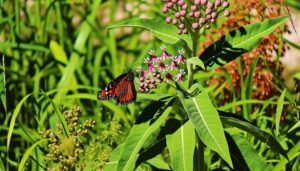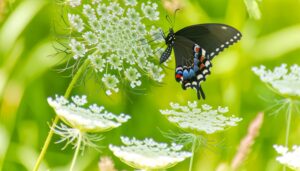How to Distinguish the Difference Between Queen and Soldier Butterflies
The Queen Butterfly (Danaus gilippus) and Soldier Butterfly (Danaus eresimus) belong to the same subfamily Danainae, but differ in wing patterns and habitat preferences. The Queen exhibits a rich chestnut-brown coloration with black borders and white spots, while the Soldier features intricate black veining and muted brown hues.
The Queen inhabits open, sunny areas in southern U.S. and Central America, whereas the Soldier prefers dense, tropical forests in the Caribbean and parts of Central/South America.
These distinctions influence their ecological roles and predator avoidance strategies, offering deeper insights into their adaptive behaviors and conservation needs.

Key Takeaways
- Physical Appearance: Queen butterflies have chestnut-brown wings with black borders and white spots, while Soldier butterflies exhibit intricate black veining and muted brownish tones.
- Habitat Preference: Queen butterflies thrive in sunny meadows and fields, whereas Soldier butterflies prefer dense tropical and subtropical forests with high humidity.
- Geographic Range: Queen butterflies are found in the southern U.S., Central, and South America, while Soldier butterflies are localized to the Caribbean and parts of Central/South America.
- Feeding Habits: Queen butterflies specialize in feeding on milkweed, while Soldier butterflies have a broader floral diet, including lantana.
Taxonomy and Classification

Queen and Soldier butterflies, though often confused due to their similar appearances, belong to distinct taxonomic classifications that can be precisely delineated through scientific nomenclature.
The Queen butterfly (Danaus gilippus) is categorized under the subfamily Danainae within the family Nymphalidae. In contrast, the Soldier butterfly (Danaus eresimus) also belongs to the same subfamily Danainae and family Nymphalidae but is classified as a different species.
Both species share the same genus, Danaus, which groups them closely yet distinctly within the broader taxonomic framework.
This nuanced taxonomic differentiation underscores the importance of precise scientific classification in distinguishing between species that exhibit convergent evolutionary traits, ensuring clarity in ecological studies and conservation efforts.
Physical Appearance
The physical appearance of the Queen and Soldier butterflies can be distinguished by examining their wing pattern variations and coloration differences. The Queen butterfly has a rich reddish-brown coloration with black borders and white spots, whereas the Soldier butterfly closely resembles it but has more intricate vein patterns on its wings. Additionally, to identify male vs female Queen butterflies, one can look for the presence of specialized black scent patches on the hindwings of males, which are absent in females. These distinct features help differentiate not only between the two species but also between male and female Queen butterflies.
The Queen butterfly (Danaus gilippus) exhibits a more uniform orange-brown coloration with white spots and black borders, while the Soldier butterfly (Danaus eresimus) displays a more intricate pattern with additional black veins and spots.
These morphological distinctions are essential for accurate species identification and understanding their respective ecological adaptations.
Wing Pattern Variations
Distinct wing pattern variations are a key distinguishing factor between queen and soldier butterflies, providing critical insights for accurate species identification.
The queen butterfly (Danaus gilippus) exhibits a more uniform wing pattern characterized by a series of white spots along the outer margins of the forewings. These spots are more pronounced and consistent than those found in the soldier butterfly (Danaus eresimus).
In contrast, the soldier butterfly presents a wing pattern with less defined and more irregular white markings. Additionally, the soldier butterfly's wing veins are more prominently outlined in dark colors, contributing to a more intricate and less uniform appearance.
These observations are fundamental for entomologists and lepidopterists in the precise classification and study of these species.
Coloration Differences
Coloration differences between Danaus gilippus and Danaus eresimus serve as an essential diagnostic feature, with the former displaying a more vibrant orange hue contrasted by the latter's subtler, brownish tones.
Danaus gilippus, commonly known as the Queen butterfly, exhibits a bold orange coloration with black and white markings, making it easily distinguishable.
In contrast, Danaus eresimus, or the Soldier butterfly, presents a more muted palette, where the brownish-orange wings are less striking and incorporate a more diffuse pattern of spots and lines.
These differences in pigmentation and patterning are not merely aesthetic but play pivotal roles in their ecological interactions, such as predator avoidance and mate selection, thereby influencing their respective survival strategies.
Wing Patterns

Queen and Soldier butterflies exhibit distinct wing patterns that serve as key identifiers within the Danaus genus.
The Queen butterfly (Danaus gilippus) displays a primarily chestnut-brown coloration with black wing borders and scattered white spots. Remarkably, the hindwings lack the bold black veins characteristic of other Danaus species.
In contrast, the Soldier butterfly (Danaus eresimus) features more intricate black veining on both forewings and hindwings, presenting a more complex pattern. Additionally, the Soldier's wings include fainter white spots and a darker, more muted coloration compared to the Queen.
These differences in wing patterns are essential for species identification and contribute to their ecological interactions, such as mating behavior and predator avoidance, within their respective environments.
Habitat and Range
The Queen butterfly (Danaus gilippus) and the Soldier butterfly (Danaus eresimus) exhibit distinct habitat preferences and geographic distributions.
Queen butterflies are mainly found in the southern United States, Central America, and parts of South America, thriving in open, sunny environments such as fields and meadows.
In contrast, Soldier butterflies are generally restricted to tropical and subtropical regions, favoring forest edges and other shaded areas.
Geographic Distribution
Examining the geographic distribution of Queen and Soldier butterflies reveals distinct habitat preferences and range limitations for each species. The Queen butterfly (Danaus gilippus) is mainly found in the southern United States, Central America, and parts of South America. In contrast, the Soldier butterfly (Danaus eresimus) is more localized to the Caribbean and certain regions of Central and South America. These differences in distribution are influenced by various ecological factors, including host plant availability and climate conditions. Understanding these geographical distinctions is essential for conservation efforts and ecological studies.
| Butterfly Species | Geographic Range | Notable Locations |
|---|---|---|
| Queen | Southern U.S., Central America | Texas, Florida, Mexico |
| Soldier | Caribbean, Central America | Cuba, Jamaica, Costa Rica |
These butterflies' distributions highlight the importance of regional conservation strategies.
Preferred Environments
Considering their distinct geographic distributions, each species exhibits unique habitat preferences and environmental requirements.
The Queen butterfly (Danaus gilippus) typically thrives in open, sunny habitats such as meadows, fields, and roadsides. It prefers regions with abundant milkweed, its larval host plant, and nectar sources, ranging from the southern United States to South America.
Conversely, the Soldier butterfly (Danaus eresimus) favors dense, tropical, and subtropical forests, often found in areas extending from southern Texas to Central America. This species shows a marked preference for shaded environments with high humidity and diverse plant life.
Both species are vital indicators of ecosystem health, reflecting the integrity of their respective habitats through their presence and behavior.
Life Cycle Stages

Both the Queen and Soldier butterflies undergo a complete metamorphosis, encompassing four distinct stages: egg, larva, pupa, and adult.
Initially, eggs are laid on host plants, specific to each species.
The larval stage, or caterpillar, follows, characterized by voracious feeding and significant growth. During this stage, both species exhibit distinct coloration and patterns that aid in identification.
The pupa, or chrysalis, stage is a period of transformation where the larval body reorganizes into the adult form.
Finally, the adult butterfly emerges, displaying fully developed wings and reproductive structures.
Despite similarities in their metamorphic process, variations in duration and morphology at each stage are observed between the Queen and Soldier butterflies, reflecting their unique evolutionary adaptations.
Feeding Habits
The feeding habits of Queen and Soldier butterflies exhibit distinct preferences and behaviors that align with their ecological roles and evolutionary adaptations. Both species, while generally nectarivorous, derive sustenance from different floral sources and employ unique foraging strategies.
The Queen butterfly (Danaus gilippus) primarily frequents milkweed plants, benefiting from the toxic cardenolides which confer predator deterrence. In contrast, the Soldier butterfly (Danaus eresimus) also visits lantana and shepherd's needle, reflecting a broader floral palette.
- Queen Butterfly: Specializes in milkweed, utilizing its toxins
- Soldier Butterfly: Feeds on a wider variety of flowers, including lantana
- Nectar Source: Both rely heavily on nectar for energy and survival
These feeding habits illustrate their ecological niches and adaptive strategies.
Behavior and Migration

Queen and Soldier butterflies exhibit distinct migratory behaviors, with the Queen engaging in occasional short-distance movements while the Soldier undertakes more extensive seasonal migrations.
Queen butterflies typically wander within their local habitats, adjusting to environmental changes without significant long-range travel.
In contrast, Soldier butterflies demonstrate a pronounced migratory pattern, traversing considerable distances to exploit seasonal resources and suitable breeding grounds. These migrations are driven by climatic variations and availability of host plants.
The Soldier's migratory flights can cover multiple generations, showcasing a complex, inherited behavior essential for survival.
Such divergence in migration highlights the adaptive strategies each species employs to optimize resource utilization and reproductive success within their respective ecological niches.
Predators and Defense Mechanisms
Soldier and Queen butterflies employ a variety of defense mechanisms to deter predators, leveraging both chemical and behavioral strategies.
These butterflies are known for sequestering toxins from their host plants, primarily milkweed, which makes them unpalatable to many predators. Additionally, their vibrant coloration serves as an aposematic signal, warning potential threats of their toxicity. Both species also exhibit behaviors such as erratic flight patterns to evade capture.
- Chemical Defense: Sequestering cardiac glycosides from milkweed.
- Aposematism: Bright coloration warning of toxicity.
- Behavioral Evasion: Erratic flight to avoid predators.
These mechanisms collectively form a robust defense strategy, ensuring higher survival rates in their natural habitats.
Conclusion
To conclude, Queen and Soldier butterflies, while sharing certain taxonomic similarities, exhibit distinct differences in physical appearance, wing patterns, habitat preferences, and behavioral traits.
The Queen butterfly's striking coloration and the Soldier's more subdued palette are evolutionary adaptations to their respective environments.
Their divergent life cycles and feeding habits further highlight the ecological niches they occupy.
Understanding these differences is akin to decoding nature's ancient manuscript, revealing the intricate balance and diversity within Lepidoptera.






